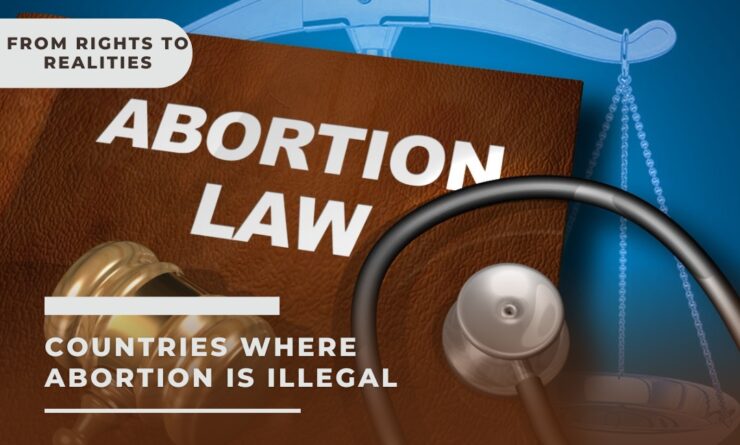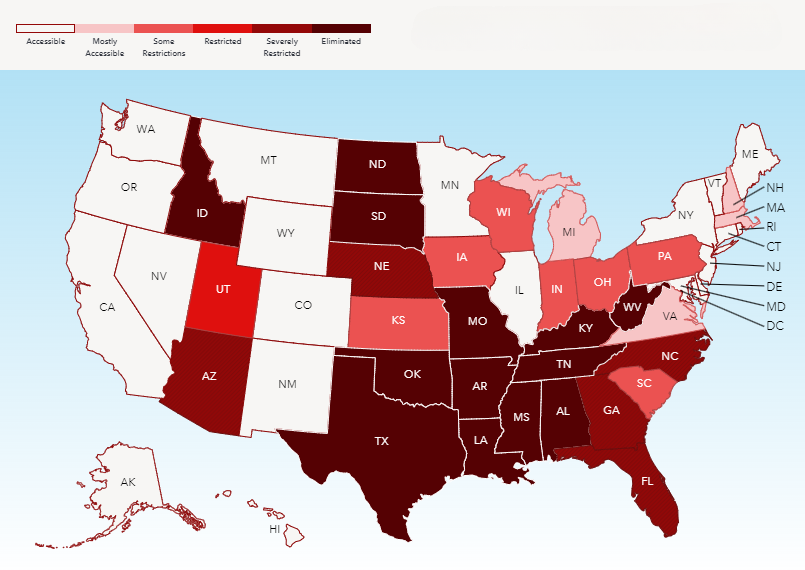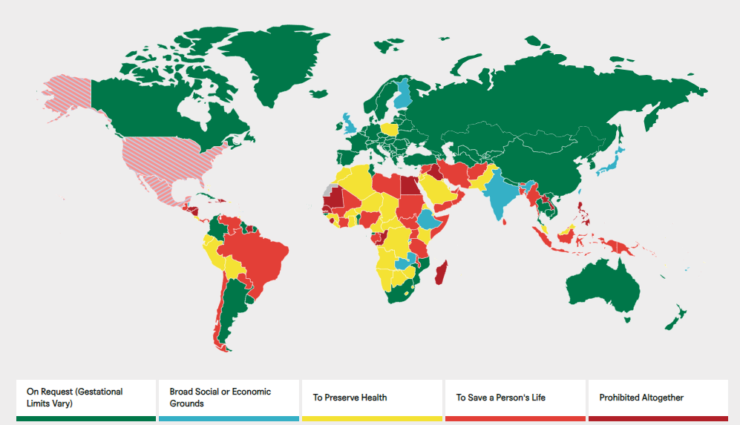Abortion, the act of ending a pregnancy through medical intervention, has long been a topic of intense debate. At its core, it’s not just a medical decision but one deeply intertwined with personal, moral, religious, and political sentiments.
The crux of the matter rests between a woman’s right to make decisions about her own body and the unborn fetus’s right to life. It’s a delicate balancing act of two profound rights, often viewed as opposing each other.
This intricate interplay of values is reflected in the diverse abortion regulations across countries and even among U.S. states, emphasizing the complexity and sensitivity of the issue.
Navigating the Intricacies of Abortion Laws
Abortion laws present a tapestry of variations worldwide. By 2021, a striking number of 24 countries completely prohibit abortion, no exceptions.
However, the majority of nations take a more layered stance. Gestational limits, ranging broadly from 6 to 24 weeks, are often set to define the timeframe within which abortion is permissible. Many laws pivot around milestones in fetal development, with 12 weeks being a common benchmark.
There are exceptions, often anchored in unique circumstances. For instance, many countries recognize cases involving rape, incest, or significant fetal abnormalities as legitimate grounds for abortion. Interestingly, gender-specific abortions are permitted in some Asian countries, reflecting cultural preferences for male offspring.
A mother’s well-being is paramount. In 37 countries, abortion becomes an option if it’s essential to save the mother’s life. Some extend this exception to situations where the mother’s overall health during pregnancy might be jeopardized, like in the case of ectopic pregnancies.
These occur when the embryo settles outside the uterus, such as in the fallopian tubes, making it unsustainable and potentially life-threatening for the mother.
Economic considerations also play a role. In specific regions, if bringing the pregnancy to full term would plunge the woman into debilitating financial distress, abortion becomes an available choice. Research underscores the economic repercussions of restricted abortion access, with affected women facing a heightened risk of falling into poverty.
Many countries layer their laws with supplementary guidelines. They might necessitate parental or spousal consent, limit access to fetal gender detection methods, or even mandate that the woman undergoes an ultrasound or listens to the fetus’s heartbeat before making her decision.
In essence, abortion laws are multifaceted, reflecting the intricate interplay of ethics, cultural values, and socio-economic realities.
Countries in Which Abortion Is Completely Illegal/prohibited*:
| Andorra | Haiti | Malta | Republic of the Congo |
| Aruba | Honduras | Mauritania | San Marino |
| Curaçao (territory) | Iraq | Nicaragua | Senegal |
| Dominican Republic | Jamaica | Palau | Sierra Leone |
| Laos | Palestine | Suriname | Tonga |
| El Salvador | Madagascar | Philippines |
The Unseen Consequences of Outlawing Abortion
While the conversation around abortion often focuses on morality and rights, there’s a tangible side to this issue that is frequently overlooked: the practical effects of making abortion illegal.
World Health Organization (WHO) data paints a telling picture. The frequency of abortions remains relatively consistent irrespective of their legal status in a country. Simply put, outlawing abortion doesn’t curtail its occurrence. However, the safety net provided by legal channels becomes inaccessible, dramatically affecting the safety of these procedures.
When women lack legal avenues, many are compelled to seek underground or “DIY” abortion methods. These illegal methods might involve non-medical practitioners, unsanitary environments, or hazardous techniques, increasing the risks of complications, infections, and even death.
In essence, the debate isn’t about whether abortions will happen – it’s about ensuring they are safe for women. By making abortions illegal, we may inadvertently be trading a regulated, clinical process for clandestine, high-risk alternatives.
A Glimpse into Abortion Laws of Key Nations
1. United States:
-
- The U.S.’s stance on abortion saw a seismic shift in 2022. The historic 1973 Roe v. Wade judgment, which legalized abortion across the nation, was nullified by the Supreme Court’s ruling in the case of Dobbs v. Jackson Women’s Health Organization.
- Prior to the 1973 decision, abortion was prohibited in 30 states. Following the 2022 judgment, more than 20 states moved rapidly to reinstate the ban, largely in the central and southern U.S. Some were ‘trigger laws’ activated by Roe v. Wade’s overturning.
The emerging restrictions on abortion appear to be tougher now than they were in the pre-Roe v. Wade era, exemplified by a Texas law enabling individuals to sue abortion providers or anyone assisting in the process.
2. Brazil:
-
-
- While Brazil does not entirely ban abortion, its regulations are stringent. Exceptions include rape, incest, or when the mother’s life is at stake – conditions fairly common in global abortion laws.
- While Brazil does not entirely ban abortion, its regulations are stringent. Exceptions include rape, incest, or when the mother’s life is at stake – conditions fairly common in global abortion laws.
-
3. Canada:
-
-
-
- Canada stands at the liberal end of the spectrum. Abortions are permissible without a specified reason but are subject to gestational limits, which vary between provinces and territories (from 12 weeks up to almost 25 weeks).
- Abortions were once largely illegal until 1988 when the Canadian Supreme Court abolished the restrictive laws. Most abortions are free of charge under Canada’s national health system, depending on the place of procedure.
-
-
4. Russia:
-
- Russia permits abortions up to the 12th week of pregnancy. For rape victims, the limit extends to 22 weeks, and for pregnancies endangering the mother’s life, there’s no gestational constraint.
- Russia was groundbreaking in 1920 when it legalized abortion for any cause, though a broad ban was later introduced in 1936. However, this prohibition was rescinded in 1955, and Russia has since then maintained open access to abortion. As of 2010, it held the highest number of abortions per capita globally.
List of Countries of The World and Their Abortion Laws:
The table below displays the general details of each country’s legal stance on abortion.
- On Request — Abortion for any reason is legal, though gestational limits still apply.
- Save Life — Abortion is legal when necessary to save the life of the woman.
- Physical Health — Abortion is legal when pregnancy risks significant (but non-fatal) injury to the woman.
- Mental Health — Abortion is legal when pregnancy puts the woman’s mental/emotional health at risk.
- Rape — Abortion is legal when the pregnancy is the result of rape.
- Incest — Abortion is legal when the pregnancy is the result of incest.
- Cognitively Disabled — Abortion is legal when the woman is mentally or cognitively disabled.
- Fetal Impairment — Abortion is legal when the fetus is known to have significant mental disabilities or physical malformations. As these can range from non-life-threatening conditions such as Down Syndrome to 100% fatal conditions such as anencephaly, more granular guidelines are often necessary.
- Socioeconomic — Abortion is legal when the woman is financially unable to support the child.
| Country | Abortion on Request |
|---|---|
| Afghanistan | To save the mother’s life |
| Albania | No restriction |
| Algeria | To preserve physical/mental health |
| Andorra | Prohibited altogether |
| Angola | Prohibited altogether |
| Antigua And Barbuda | To save the mother’s life |
| Argentina | No restriction |
| Armenia | No restriction |
| Australia | No restriction |
| Austria | No restriction |
| Azerbaijan | No restriction |
| Bahamas | To preserve physical health |
| Bahrain | No restriction |
| Bangladesh | To save the mother’s life |
| Barbados | To preserve health/on socioeconomic grounds |
| Belarus | No restriction |
| Belgium | No restriction |
| Belize | To preserve health/on socioeconomic grounds |
| Benin | To preserve physical health |
| Bhutan | To save the mother’s life |
| Bolivia | To preserve physical health |
| Bosnia And Herzegovina | No restriction |
| Botswana | To preserve physical/mental health |
| Brazil | To save the mother’s life |
| Bulgaria | No restriction |
| Burkina Faso | To preserve physical health |
| Burundi | To preserve physical health |
| Cambodia | No restriction |
| Cameroon | To preserve physical health |
| Canada | No restriction |
| Cape Verde | No restriction |
| Central African Republic | To preserve physical health |
| Chad | To preserve physical health |
| Chile | To save the mother’s life |
| Colombia | To preserve physical/mental health |
| Comoros | To preserve physical health |
| Costa Rica | To preserve physical health |
| Croatia | No restriction |
| Cuba | No restriction |
| Cyprus | To preserve health/on socioeconomic grounds |
| Czech Republic | No restriction |
| Denmark | No restriction |
| Djibouti | To preserve physical health |
| Dominica | To save the mother’s life |
| Dominican Republic | Prohibited altogether |
| Dr Congo | Prohibited altogether |
| Ecuador | To preserve physical health |
| Egypt | To save the mother’s life |
| El Salvador | Prohibited altogether |
| Equatorial Guinea | To preserve physical health |
| Eritrea | To preserve physical/mental health |
| Estonia | No restriction |
| Eswatini | To preserve physical/mental health |
| Ethiopia | To preserve physical health |
| Fiji | To preserve health/on socioeconomic grounds |
| Finland | To preserve health/on socioeconomic grounds |
| France | No restriction |
| Gabon | Prohibited altogether |
| Gambia | To preserve physical/mental health |
| Germany | No restriction |
| Ghana | To preserve physical/mental health |
| Greece | No restriction |
| Grenada | To preserve physical health |
| Guatemala | To save the mother’s life |
| Guinea | To preserve physical health |
| Guyana | No restriction |
| Haiti | Prohibited altogether |
| Honduras | Prohibited altogether |
| Hong Kong | To preserve health/on socioeconomic grounds |
| Hungary | No restriction |
| Iceland | To preserve health/on socioeconomic grounds |
| India | To preserve health/on socioeconomic grounds |
| Indonesia | To save the mother’s life |
| Iran | To save the mother’s life |
| Iraq | Prohibited altogether |
| Ireland | No restriction before 12 weeks |
| Israel | To preserve physical/mental health |
| Italy | No restriction |
| Ivory Coast | To save the mother’s life |
| Jamaica | To preserve physical/mental health |
| Japan | To preserve health/on socioeconomic grounds |
| Jordan | To preserve physical health |
| Kazakhstan | No restriction |
| Kenya | To preserve physical health |
| Kiribati | To save the mother’s life |
| Kuwait | To preserve physical health |
| Kyrgyzstan | No restriction |
| Laos | Prohibited altogether |
| Latvia | No restriction |
| Lebanon | To save the mother’s life |
| Lesotho | To preserve physical health |
| Liberia | To preserve physical/mental health |
| Libya | To save the mother’s life |
| Liechtenstein | To preserve physical health |
| Lithuania | No restriction |
| Luxembourg | No restriction |
| Madagascar | Prohibited altogether |
| Malawi | To save the mother’s life |
| Malaysia | To preserve physical/mental health |
| Maldives | To preserve physical health |
| Mali | To save the mother’s life |
| Malta | Prohibited altogether |
| Marshall Islands | Prohibited altogether |
| Mauritania | Prohibited altogether |
| Mauritius | To preserve physical/mental health |
| Mexico | To save the mother’s life |
| Micronesia | Prohibited altogether |
| Moldova | No restriction |
| Monaco | To preserve physical health |
| Mongolia | No restriction |
| Montenegro | No restriction |
| Morocco | To preserve physical health |
| Mozambique | To preserve physical/mental health |
| Myanmar | To save the mother’s life |
| Namibia | To preserve physical/mental health |
| Nauru | To preserve physical/mental health |
| Nepal | No restriction |
| Netherlands | No restriction |
| New Zealand | No restriction before 20 weeks |
| Nicaragua | Prohibited altogether |
| Niger | To preserve physical health |
| Nigeria | To save the mother’s life |
| North Korea | No restriction |
| North Macedonia | No restriction |
| Norway | No restriction |
| Oman | To save the mother’s life |
| Pakistan | To preserve physical health |
| Palau | Prohibited altogether |
| Panama | To save the mother’s life |
| Papua New Guinea | To save the mother’s life |
| Paraguay | To save the mother’s life |
| Peru | To preserve physical health |
| Philippines | Prohibited altogether |
| Poland | To preserve physical health |
| Portugal | No restriction |
| Qatar | To preserve physical health |
| Republic Of The Congo | Prohibited altogether |
| Romania | No restriction |
| Russia | No restriction |
| Rwanda | To preserve physical health |
| Saint Kitts And Nevis | To preserve physical/mental health |
| Saint Lucia | To preserve physical/mental health |
| Saint Vincent And The Grenadines | To preserve health/on socioeconomic grounds |
| Samoa | To preserve physical/mental health |
| San Marino | Prohibited altogether |
| Sao Tome And Principe | Prohibited altogether |
| Saudi Arabia | To preserve physical health |
| Senegal | Prohibited altogether |
| Serbia | No restriction |
| Seychelles | To preserve physical/mental health |
| Sierra Leone | To preserve physical/mental health |
| Singapore | No restriction |
| Slovakia | No restriction |
| Slovenia | No restriction |
| Solomon Islands | To save the mother’s life |
| Somalia | To save the mother’s life |
| South Africa | No restriction |
| South Korea | To preserve physical health |
| South Sudan | To save the mother’s life |
| Spain | No restriction |
| Sri Lanka | To save the mother’s life |
| Sudan | To save the mother’s life |
| Suriname | Prohibited altogether |
| Sweden | No restriction |
| Switzerland | No restriction |
| Syria | To save the mother’s life |
| Taiwan | To preserve health/on socioeconomic grounds |
| Tajikistan | No restriction |
| Tanzania | To save the mother’s life |
| Thailand | To preserve physical/mental health |
| Timor Leste | To save the mother’s life |
| Togo | To preserve physical health |
| Tonga | Prohibited altogether |
| Trinidad And Tobago | To preserve physical/mental health |
| Tunisia | No restriction |
| Turkey | No restriction |
| Turkmenistan | No restriction |
| Tuvalu | To save the mother’s life |
| Uganda | To save the mother’s life |
| Ukraine | No restriction |
| United Arab Emirates | To save the mother’s life |
| United Kingdom | To preserve health/on socioeconomic grounds |
| United States | Varies by state |
| Uruguay | No restriction |
| Uzbekistan | No restriction |
| Vanuatu | To preserve physical health |
| Venezuela | To save the mother’s life |
| Vietnam | No restriction |
| Yemen | To save the mother’s life |
| Zambia | To preserve health/on socioeconomic grounds |
| Zimbabwe | To preserve physical health |
Final Words
Abortion laws and regulations reflect the socio-cultural and ethical values of each country. While it’s important to acknowledge and respect individual and collective beliefs, the impact of these laws on women’s health and well-being cannot be ignored.
The essence of the debate revolves not only around personal or religious convictions but also on the practical and real-world consequences of these decisions. Policies that strike a balance between these aspects are crucial for the betterment of society at large.
Ultimately, ensuring access to safe and legal abortion services not only respects women’s rights but also serves as a preventive measure against potential health hazards.
The ongoing dialogues and debates surrounding abortion emphasize the importance of understanding diverse perspectives and finding a middle ground in a complex and sensitive issue.


















